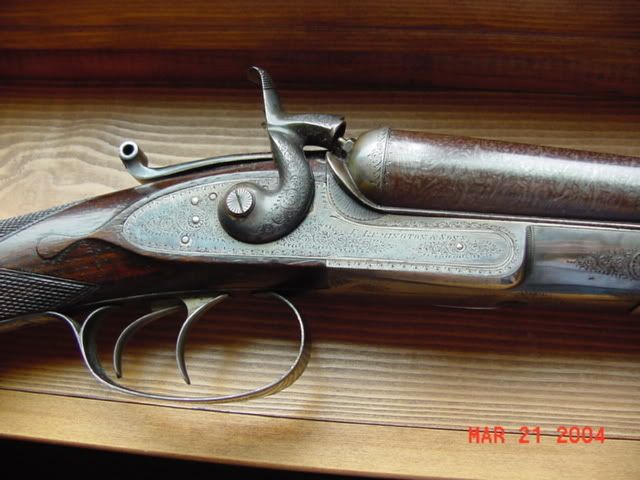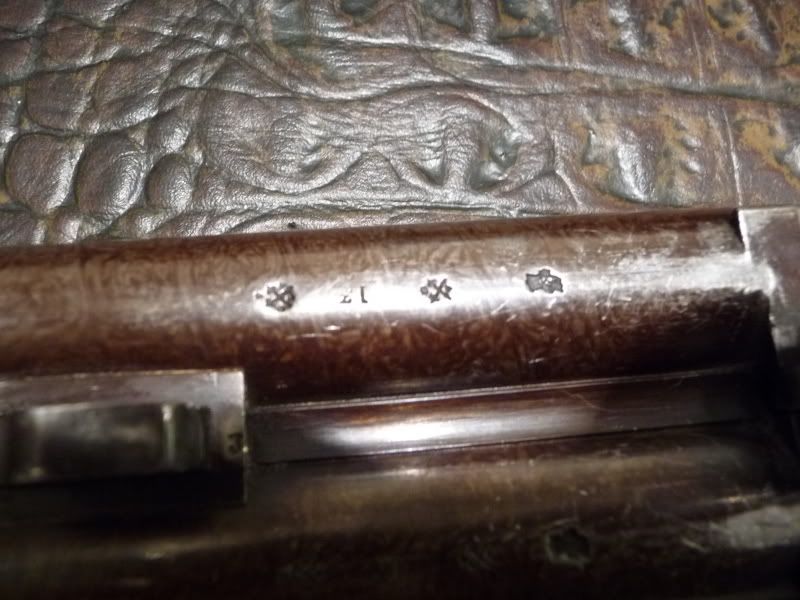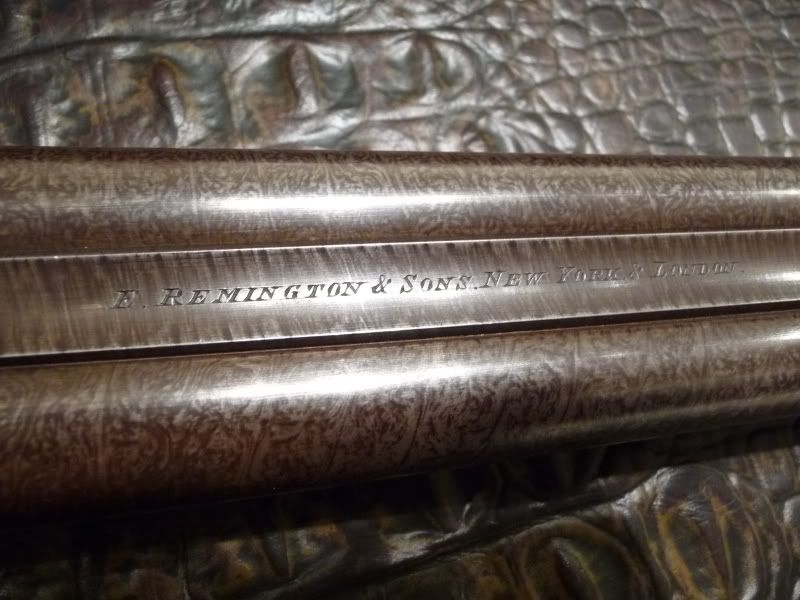Gentlemen;
My two-year quest for a 10ga hammer double came to an end Saturday thanks to the Lacey, WA Cabella's store. From what the gent in the Gun Library told me, they received an older gentleman's shotgun collection which ran heavy into older doubles, many of them 10 gauges. In and amongst the pile was a "Rival" field grade 10ga with 30" Damascus barrels. The chambers are 2 7/8" long, but I have no idea how it is choked. This beast is in probably 80-85% condition, complete with color case hardening, a very tight action, and clear Damascus patterns on the barrels. The bores shine like a new dime! I took it apart, hung the barrels and they ring very clearly, with no strange vibrations or rattling. The only glitch I can see (apart from a few dings in the wood) is a small dent in the right barrel, about 3/4 of the way up the bore. I realize this is not a high end gun, but I would like to shoot it. I already load BP shotshells for 12ga, and I am gathering components right now to reload for 10ga. I have a local 'smith who specializes in older rifles and shotguns and plan on having him give it a once-over. If I post a picture of the proof marks, can someone give me an idea as to what it is proofed for? Also, is it possible to repair a dent in Damascus without compromising the weld? Any information on this particular shotgun or 10ga BP loads in general would be greatly appreciated. Thank you for your time.
V/R
Mossyrock


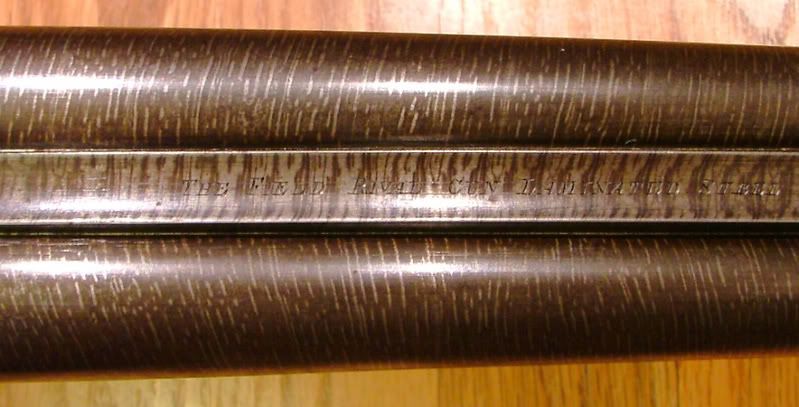
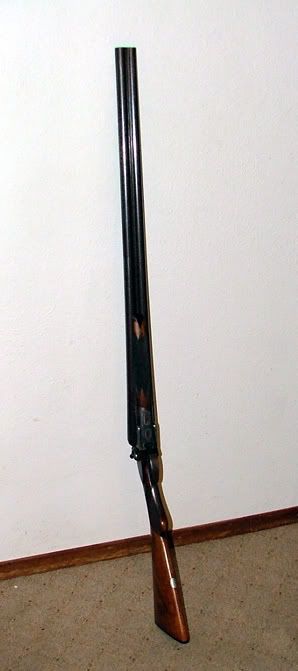
Mossyrock, welcome to the BBS. I think you'll find over time it is a vast reservoir of information for these old doubles. Looks to me as though you've bought a great 10 bore double that is screaming to be shot. The dent will need to be knocked out by a competent smith. Evidently you're in the Northwest so I'd suggest you contact Keith Kearcher in Bend, Oregon for the barrel work. He is competent and has a fairly fast turnaround. I'm sure you'll find other 10 gauge fanatics in the area but Terry Lubinski, a frequent poster on this site, lives in Vancouver and probably knows more about these guns than anyone I am familiar with. Betcha he chimes in before long. Good luck! Oh, you'll find that reloading for the gun is simple and there are a number of low pressure receipes around. When you come to that stage, send me an e-mail and I'll give you some of my favorite load data.
Man, that's nice! I just picked up a twin to your's in 12 gauge! Have you found any indication on age?
... In and amongst the pile was a "Rival" field grade 10ga with 30" Damascus barrels. .... The only glitch I can see (apart from a few dings in the wood) is a small dent in the right barrel, about 3/4 of the way up the bore. .... Also, is it possible to repair a dent in Damascus without compromising the weld? Any information on this particular shotgun or 10ga BP loads in general would be greatly appreciated. Thank you for your time.
Rival is a known trade name of Crescent. The Rival was made for the Van Camp Hardware and Iron Company of Indianapolis, Indiana. They were cheap, utility guns when they were made, mostly selling for under $20.00. The barrels were produced in Belgium to a very low price point, usually under $2.00 for both tubes.
Like almost all of these guns, yours has Twist / Laminated damascus barrels.
The skill to repair damaged damascus is long gone. The gun needs to be examined carefully by a gunsmith like Terry who understands older guns and damascus. Depending on exactly where the damage is, the gun may be shootable as is.
Pete
I think the proofmarks will be interesting, if it has any. I have seen a couple of Rival guns and , like Pete said, they were Crescent "looking". But, I think your gun is a bit different and maybe it's because it's so well preserved. I think the sculpting around the breech , the hammers, the metal to metal fit, and the metal to wood fit are better than the Crescents I have seen. It also has what looks like a gold shield in the bottom of the buttstock. I wonder if their were European "Rival" named shotguns, too.
Man, that's nice! I just picked up a twin to your's in 12 gauge! Have you found any indication on age?
None at all. I can't even find it in any of the reference books I have on hand.
I think the proofmarks will be interesting, if it has any. I have seen a couple of Rival guns and , like Pete said, they were Crescent "looking". But, I think your gun is a bit different and maybe it's because it's so well preserved. I think the sculpting around the breech , the hammers, the metal to metal fit, and the metal to wood fit are better than the Crescents I have seen. It also has what looks like a gold shield in the bottom of the buttstock. I wonder if their were European "Rival" named shotguns, too.
It is actually a silver oval. It has proof marks. I will have to highlight them with correction fluid and try to get a picture.
If Crescents hammerguns had grooves in the stock head to accomadate the hammers (like Rocketfoot's does), this must not be a Crescent...no grooves...Geo
If Crescents hammerguns had grooves in the stock head to accomadate the hammers (like Rocketfoot's does), this must not be a Crescent...no grooves...Geo
Well if it's a Crescent, the rule is ..some do some don't. Probably depends on the date of mfg. I have seen both and the breech on this gun is different from the other 12 ga. We also can't really see that area in the pictures.
Look for Birmingham Proofs ?
Gentlemen;
Here are the proof marks on the underside of the barrel. can anyone translate these into English for me? What do I have here?
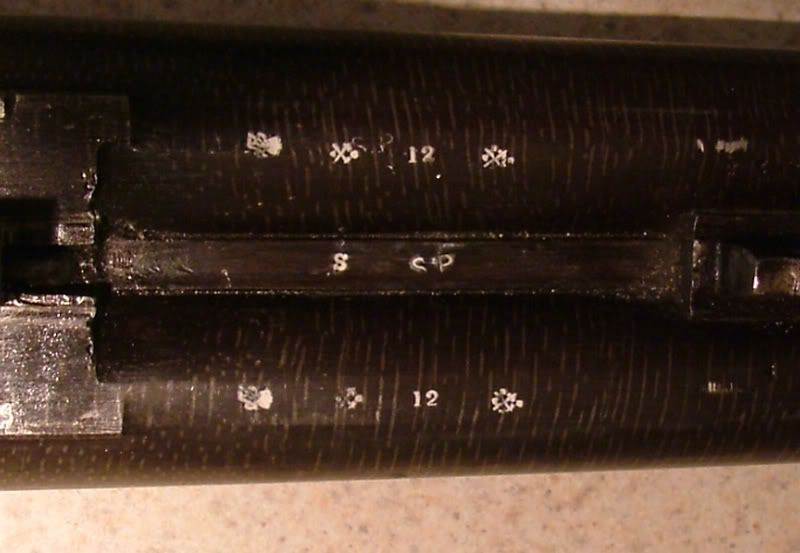
Mossy, can you give a picture of the flats of the barrels showing what is there ? Your pictures are quite good. Are you sure your gun is a 10 ga. ? Daryl
Daryl,
I am positive it is a 10 bore. 10 gauge snaps caps drop into the chambers, and the muzzle end of the bore measures .758". If my math is correct, that should be pretty close to a Modified choke, right? The "12" markings on the barrels threw me as well. The markings you see above are the only markings on the underside of the barrel, with these being the only markings on top:

Pete is that a wire twist ?
The rib on the Rival says "Laminated Steel" and looks no different than the Laminated on my 44XL.
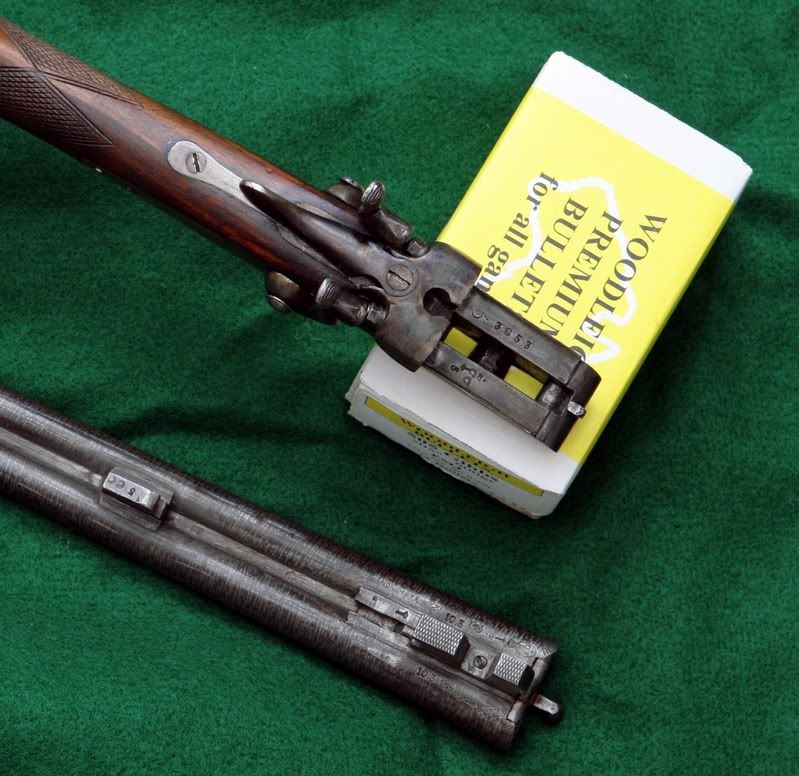
Wire Twist and Laminated Steel would have the same meaning. Both are ways of saying a twisted billet that is forge welded.
It is curious that the marks on the Rival appear British. Which raises many questions in my mind.
Pete
So, does the "12" signify the amount of pressure for which the barrels are proofed?
Mossy, I see the Birmingham Black Powder proof, Birmingham inspection mark, the S for Servicable, and I think I see SP, but am not sure what that is. One question on the 12. Can you measure the bores ? Every once in a while, one sees guns with a chamber larger than usually associated with the bore. If not a 12 ga bore, I don't know what the 12 is. Maybe some better on proofmarks than I can tell.
I believe your gun was made in England, probably Birmingham and probably with imported tubes from Belgium, but we can not be sure of that. It was exported to the US sometime after 1868 and before 1904. Does it have chokes ? If so, to have the marks proper, the gun would be pre 1875.
I assume there are no marks on the receiver flats. Can you take off a lockplate and see if there are marks on the inside ?
Mossy, I see the Birmingham Black Powder proof, Birmingham inspection mark, the S for Servicable, and I think I see SP, but am not sure what that is. One question on the 12. Can you measure the bores ? Every once in a while, one sees guns with a chamber larger than usually associated with the bore. If not a 12 ga bore, I don't know what the 12 is. Maybe some better on proofmarks than I can tell.
I believe your gun was made in England, probably Birmingham and probably with imported tubes from Belgium, but we can not be sure of that. It was exported to the US sometime after 1868 and before 1904. Does it have chokes ? If so, to have the marks proper, the gun would be pre 1875.
I assume there are no marks on the receiver flats. Can you take off a lockplate and see if there are marks on the inside ?
The muzzle end of the bores measure .758" with my calipers. I will take a look at the reciever flats and under the lockplates. I had the locks out and was amazed at how clean they were. It's like this thing just stepped out of a time machine!
That gun was prooved in the UK as a12-bore. If it accepts a 10-bore cartrige now it could have been enlarged subsequent to these proof marks being stamped.
Alternatively it could have chambers cut for a particular cartridge. Measuring the bores at 9" from the breech end should provide some useful data in this regard.
That gun was prooved in the UK as a12-bore. If it accepts a 10-bore cartrige now it could have been enlarged subsequent to these proof marks being stamped.
Alternatively it could have chambers cut for a particular cartridge. Measuring the bores at 9" from the breech end should provide some useful data in this regard.
I will need to take it to a specialist for that measurement. I don't have the tools on hand to do that.
Mossy and Small Bore, here is an 1875 Remington Whitmore , Grade 5, made for the London market. It is marked like your gun, only in London. Note the proofs are the same, except mine has a 13, where your's has a 12. Bores of this gun, 9" from the breech, measure .722". Smallbore must be correct .
OK...does that signify that my gun was rechambered/rebored from a possible original 12 bore chambering? Hmmm...the plot thickens...
Mossy, you really need that measurement , the bore diameter 9" from the breech. From the looks of your gun I would not guess it to be altered, but anything is possible.
The Field gun illustrated is either a 10.G incorrectly stamped at the Birmingham proof house as a 12.G or a gun made in Belgium with fraudulent, incorrect, Birmingham proof marks.
My opinion is that it is a 10.G of Birmingham origin.My reasons are as follows:
1/ The gun is typical of the export guns made by the Birmingham trade in the 1880-1900,s A very similar, "export gun", is pictured on page 412 of W.W.Greeners book," The Gun."
2/ The application of proof marks to the barrels, rather than the barrel flats, was a practice used in this era by the Birmingham trade and the proof house on guns destined for export.
3/The finish on the gun is superior to that seen on Belgian guns imported and marketed by Folsom.
As for the possibility of opening up the bore of a 12.G that has barrels with the normal outside 12.G profile,it is simply impractical.The net result of an attempt at this magnitude of bore enlargementwould be; thin barrels at the proof diameter & paper thin barrels, approx; 7-8 inches from the muzzle.I Cannot believe a gun modified in this manner would have any prospect of passing legitimate proof!
As recommended by others I would not consider firing this gun until a competent gunsmith has checked all barrel dimensions.
A possible maker is:
William Field, 1881 @ 118, Unett Street, Birmingham. William field is identified in published records as being the manager of the Field Rifle Co; Birmingham 1885-1898.
Roy,
I believe you and Daryl are correct. What is interesting is the name on the barrel, "The Field Rival". It would be interesting to find another so named to see if that name applied to English made guns. As opposed to "Rival" for Belgian made.
http://books.google.com/books?id=3HMCAAA...esult#PPA397,M1
Greener spends several pages degrading any "export gun".
Pete
Roy, those are good thoughts. I just cannot think that Mossy's gun has been altered. Do you know, in that time , if they used the bore designations of even numbers ? Later we see 13/1 etc for designations, sort of narrowing the diameters related to proof. By the way, I have seen a two barrel set, British hammer gun, with one set with 10 Chamber and 12 bore. I guess the maker would try lots of things in those days.
Pete, this fellow has one marked the same.
http://www.coondawgs.com:80/forum/viewtopic.php?t=53656&sid=0bf2540e38eb347af9d2bed49041d6e9I need to say that Mossy has a very unusual gun , in that the condition is super for that type of weapon. I , and lots of others would be glad to have an example like that.
I have a side lever opener W Richards with Birmingham proofs of the same era. This gun has a 12ga chamber with the bbl marked as a 14 (.693"). As on this gun there is no chamber mark, just the provisional, definitive & view marks along with the 14. The bores on it now measure very close to a 13 (.710"). At this point in time (pre 1887 as I recall) the bore was only marked with whole sizes, no intermediates (ie 12/1 etc) being used. This bbl could have been any size which accepted the 12 (.729") plug but not an 11 (.751") one at proof. It may quite well have originated having a bore just under an 11 with a 10ga chamber & been subsequently polished/honed out to the .758" size. May well be cylinder bore, mine is.
The construction of this bbl would have been alternating layers welded, then rolled down to size leaving the layers quite thin & then wrapped around a mandrel with the layers on Edge. There would have been no twisting in the rod prior to winding (Twisting) around the mandrel. This was often called Wire Twist, but each piece which has the appearence of a wire on the outside, actually goes entirely through to the bore. If you can imagine, take a piece of laminated shim stock & cut off a strip of it. Place it across a rod with the edge showing the laminations against the rod & the outside, then procede to spiral wrap it around the rod. Each lamination would thus be visable to the outside & go through to the inside. For damascus one end of that strip would have been fastened, the other end twisted round till it looked like a threaded rod, then hammered back flat & then wound around the mandrel. You then have the so-called "Finger print" pattern rather than a plain spiral appearence. For 2-strip, 3-strip etc damascus more than one of these twisted strips would have been welded together edge wise prior to winding.
Interesting gun with a lot of history. If I understand the timing correctly, the McKinley Tarrif circa 1890 clamped down on the importation of these fine pieces from Birmingham. Mossy, you're lucky to have one in such good condition.
I just hope the boys at Cabelas didn't take him for too hard a ride.
Judge,
You are correct about the tariff. It had a major impact on the Birmingham trade.
Miller,
The process you describe is interesting. The hardest part of understanding the damascus process for me originally was to understand the geometry of the final pattern. Had to play with some clay to finally "get it".
Just a question. If the billet is composed of individual layers, shouldn't there be a candy stripe like effect from the method you describe?
Pete
I just hope the boys at Cabelas didn't take him for too hard a ride.
Less than five bills.......
So did we decide this is wire twist ?
MR you didn't get hurt too bad if you like it....
Don't take offense to what I'm saying just think about it.
Here's something to ponder when you put your eye sight and possibly your life on the line shooting these old guns.
Would you rather take the risk shooting guns 100 year old plus that were originally high quality or take you chance shooting a 100 year old plus original low quality gun that Greener claimed were unsafe when new ?
From
La Chasse Au Fusil An Essay On Shooting (An English adaptation of Marolles' original)
Gervis Francois Magne’ de Marolles 1789
http://books.google.com/books?id=-Q0AAAA...ary_s&cad=0"The Canons a’ ruban, or ribbon barrels, of the French, resemble very much the English twisted barrels (but are of a different process.)
A plate of iron, about the twelfth part of an inch in thickness, is turned round a mandril, and welded its whole length, in the same manner as a plain barrel. Upon this small and light barrel, which is called the lining (chemise), a stripe of plate iron, about an inch in breadth, and beveled off a the edges, is rolled in a spiral direction, by means of successive beats; this spiral is termed the ribbon, and its thickness much correspond with the part of the barrel it is to constitute. As a ribbon of sufficient length to cover the lining from one end to the other, would be very difficult to manage, it is formed in several pieces, and as soon as one piece is nearly rolled on another is welded to the end of it, and the operation continued until the whole of the lining is covered. The edges are beveled so much, that one edge overlaps the other about a quarter of an inch. When the ribbon is rolled on, the barrel is heated by two or three inches at a time, and the turns of the spiral united to each other and to the lining, by being welded in the same manner as a twisted or a plain barrel. It is afterwards bored so that almost the whole lining is cut out, and scarcely anything left except the ribbon with which it was covered."

p. 43 "An ingenious workman called Barrois, formerly established at Paris, and but lately dead, having considered the estimation in which ribbon barrels were held, invented a new form,
which he called wired barrels. His method was this. Upon a thin barrel, forged, filed, and drilled as usual, he rolled, in a spiral direction, and as closely as possible, a tempered iron wire, about the thickness of a crow quill; the first layer covering only the fortified or reinforced part . The turns of the wire were folded to each other, and to the barrel, with a particular composition he kept secret. He then filed the wired part as to render it smooth and bright, but not so much as to weaken it; and applied a second layer of wire, which covered the first, and extended two-thirds of the length of the barrel; the second layer being soldered like the first, he added a third that covered the first two, and reached quite to the muzzle."
Wire Twist refinished by Paul Stevens


The barrels are Plain Twist
Dr. Gaddy's English Skelp example


Dr Gaddy's Belgian Twist or
Conons Tordu or
Tors Ou Torches 
Paying attention this time jOe?
Daryl, I agree,I am of the opinion that mossyrock,s gun has never been modified.
I have seen guns fitted with origional 10&12.G barrels, but in every case the action was built as 10 G. with the 12.G barrels made to fit the 10.G action.[ still a common practice on modern guns in smaller gauge sizes.]
The 1868 rules of proof,for London and Birmingham show that every gun was to be marked with its nominal gauge. However,the rules show that for example,a 10.G bore, stamped 10, was to be divided into three specific diameters; .775 -.770-.760 [ But not marked on the gun] and that for each measured size, a different proof charge was to be used.In 1888 new rules of proof came into force. This I believe is the date when the rules of proof specified the more commonly encountered numbering system, For example 10.G bore size was restated in the rules as follows.
11=.751 11/1=.763 10=.775 10/1=.784 10/2=.793 inches.
All guns with the above series of marks were chambered for 10.g shells, chamber lengths being at the discretion of the gun maker.
All of the above bore sizes were subjected to exactly the same proof test whether tested in London or Birmingham
Roy, thanks. That seems to fill out the questions on this gun. A neat gun at a cost of 5 bills, which I hope is hundreds.
Well, the plot thickens even further. Nine inches in from the breech, the right barrel measures approximately .754". I say approximately because that's as close as I can get it with the tools I have on hand. On Friday, I will hopefully get a better measurement by making a Cerro-safe bore casting
So, any further info based on that preliminary measurement?
I'm not very knowledgeable on the subject but I was once told by an acquaintance that before the actual term for choke e.g. full, modified etc. were used the above method was used to show amount of choke. A 10 gau. with 11 /12 on the barrels would indicate ( for the sake of argument modified choke (11) and full choke (12). I have a 10 gau. with 11 on one barrel and 12 on the other (modified & full). The same gun is stamped "Not For Ball" which would indicate that the barrels were choked to some degree. FWIW --- John Can.
I'm not very knowledgeable on the subject but I was once told by an acquaintance that before the actual term for choke e.g. full, modified etc. were used the above method was used to show amount of choke. A 10 gau. with 11 /12 on the barrels would indicate ( for the sake of argument modified choke (11) and full choke (12). I have a 10 gau. with 11 on one barrel and 12 on the other (modified & full). The same gun is stamped "Not For Ball" which would indicate that the barrels were choked to some degree. FWIW --- John Can.
Now THAT is an interesting theory given that the barrels measure about the same at the bore as they do 9" up the barrel.....
Mossyrock, I don't share anyone's belief that this gun is unaltered. It may appear in beautiful condition, but you should not trust appearences. There is no reason to believe the proof mark to be incorrect or misunderstood. This gun is out of proof, and there is all the proof you need right in front of your eyes. This accounts for the price you paid. If you want to chance it you can never say you didn't know.
It is interesting, could it be that in the old days the barrels where not just "choked" the last 2 or 3 inches of barrel. What is the measurement from the chamber down say half way. Like I said I'm no expert in this arena. Just to add some info., I have a German shotgun (circa 1920) marked full choke and you can see 2 steps looking down the 26 inch barrel, one half way and then another about 4 inches from the muzzle. Things weren't always done in the past as they are to-day, Perhaps someone more knowledgeable will chime in and explain the use of 11 / 12 on on 10 gau. --- John Can.
The water table:
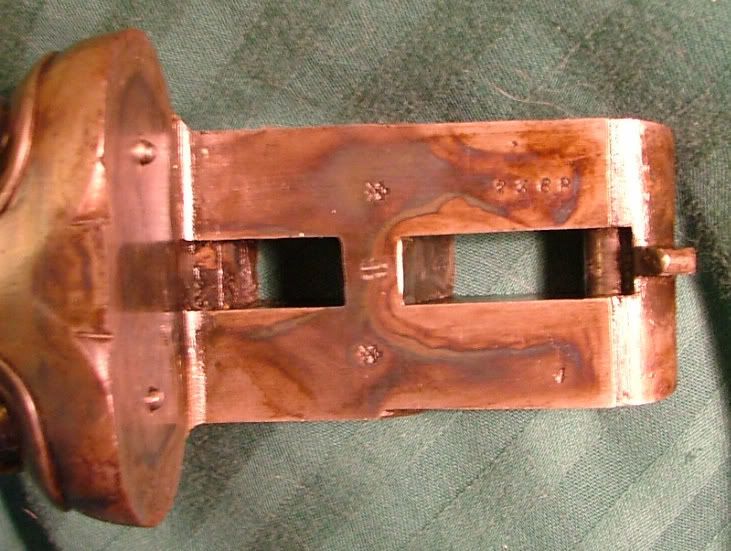
In 1875 per British rules guns with choke began to be marked with both bore & muzzle dias as 10B 11M & also the words "Not for Ball". In 1887 the nominal chamber began to be marked as 10/C in a diamond with the ga for bore & word "Choke" (if choked). At this same time the intermediate sizes also began to be marked as 12/1 for a bore of .740" up to 751" (11ga). Actual choke dia was no longer marked.
Pete;
The description I gave was paraphrased from W Greener, "The Gun 1834". Yes these bbls do have a candy stripe like appearence. The bbls as on a Lefever H etc described as "London Teist" to me have an appearence much closer to the old Stub Twist, but I do not think actual stubs were still being used. I highly suspect their makeup was of smaller pieces somewhat on the order of the older Stub bbls. There is though nothing to indicate to me they were "Twisted" in the bar prior to wrapping. The first type is generally referred to as plain twist & often called wire twist from the appearence of having been wound with wire & welded, though this was not the actual mode of construction.
Most likely answer is that the proof diameter was 11G and the muzzle diameter 12G. [IE: a choke equal to the difference in diameter between 11G and 12.G.] This would be similar to the "Not for ball" 11B 12M, found on British shotguns made between 1875 and 1877.
John;
You say your gun has 11 on one bbl & 12 on the other. Do they just have the single mark & not the dual marks with one having a B & the other an M following? It must be remembered that until the general acceptance of choke boring even breech loaders were measured by the process which had been developed during muzzle loader days, ie measured from the muzzle. Since your gun bears the stamp "Not for Ball" it would indeed indicate it was choked. While theoretically the not for ball & the dual markings for bore & muzzle came in together, it is quite conceivable some one simply marked it by the "Old Rule" & stamped muzzle dia & then added the Not for Ball realizing it was choked. In the vast majority of cases though it can be assumed if there is only a single size mark per bbl it is to be taken as bore dia, not choke. I do not think I have ever heard of a case where bore size was marked on one bbl & choke size on the other one. There are guns with the dual marking on one bbl & a single mark on the other. The bbl carrying only the single mark will be found to be cylinder, the other choked.










